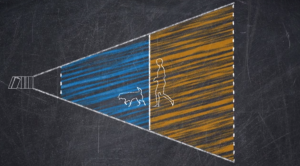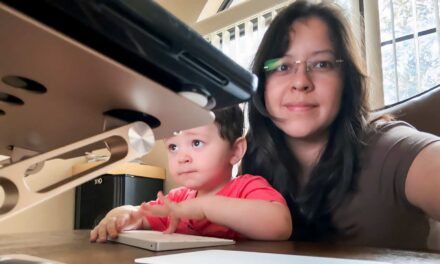
Visual tech visionaries honored with innovation awards


Lina Karam, an ASU electrical engineering professor and chair of the IEEE ICIP Conference, and Haohong Wang, TCL Research America general manager and conference innovation chair, prepare to introduce keynote speakers during the Visual Innovation Program. Photographer: Terry Grant/ASU.
Humans have been fascinated with light and optics since prehistoric times, when the first camera obscura effects — likely a pinhole in an animal hide — was used to project upside down images onto cave walls. Today, visual technologies connect us in most facets of everyday life, in our homes, our places of work and our classrooms.
Lina Karam, an electrical engineering professor at Arizona State University’s Ira A. Fulton Schools of Engineering, thought it was time to acknowledge the visionaries who have created those transformative technologies and media platforms — medical imaging, video gaming, virtual reality, 3-D imagery and video streaming on a wide range of computing and personal devices. So, she introduced the Visual Innovation Award for this year’s IEEE International Conference on Image Processing.
Karam, who chaired this year’s conference, launched the award as part of a new innovation program, which includes a technology showcase and a series of workshops presented by industry.
From a field of seven finalists, Steve Chen, co-founder of YouTube, and Ren Ng, founder of Lytro’s pocket-size light-field camera, were named as recipients of the award on Tuesday evening.
Visual Innovation Runner Up Awards were awarded to Achin Bhowmik, Intel vice president, development and deployment lead for Intel RealSense camera technology; Bill Dally, senior vice president, nVidia, chief scientist, CUDA (a graphics processing platform); Reed Hastings, co-founder and chief executive officer of Netflix; Brendan Iribe, co-founder and chief executive officer of Oculus, VR; and Alex Kipman, inventor, Microsoft Kinect (motion-sensing device).

The Lytro pocket-size light-field camera earned Ren Ng the first Visual Innovation Award launched by ASU engineer Lina Karam. Photo courtesy of illum.lytro.com/learn.
“Imagine, for the first time, visionaries from YouTube, Netflix, Intel, Microsoft, nVidia, Oculus and Lytro competing for an innovation award,” said Karam. “It’s never happened before.”
An awards committee collected online nominations from industry professionals and narrowed the field to seven finalists. As a prelude to the live vote, the finalists or company representatives presented overviews of their innovation journeys.
The winners were determined by live vote during the first two days of the conference and announced during an awards dinner.
Connecting research and industry
The idea for the award was born about three years ago, two years after Karam learned that ASU had been selected to host the 2016 conference and that she would serve as chair.
“We host conferences and present our papers, but we rarely talk about the impact our research has on society,” explained Karam. “I wanted to make a direct connection between the work we do in the image-processing field and how it affects us all in our daily lives. The Visual Innovation Award is my way of making that connection.”

Keynote speakers gather before the ICIP IEEE Innovation Program, launched this year by ASU Professor Lina Karam. From left: Michael Antonov, co-founder, Oculus; John Harding, VP, Google; Bill Dally, SVP, nVIdia; Anthony Park, VP Netflix; Tim Million, VP, Lytro, and Jamie Shotton, co-inventor, Microsoft Kinect. Photographer: Terry Grant/ASU.
Karam, who insists that innovation and technology transfer are intertwined, has worked on projects with AT&T Bell Labs (Murray Hill), Schlumberger, Intel, Qualcomm, Google, NTT, Motorola, Freescale, General Dynamics and NASA. Using the innovation program to acknowledge the contributions made by industry has also served to inspire an expanded business presence at the conference.
It was through her industry partners at Qualcomm that Karam connected with Haohong Wang, TCL Research America general manager, who agreed to serve as the ICIP innovation program chair.
“Dr. Wang’s connections within industry made the award possible,” said Karam. “He recruited the nomination committee and completely orchestrated the innovation program events, including securing top industry leaders to serve as keynote speakers.”
Wang said he signed on as innovation chair because he was inspired by the “wow factor” the program would bring to attendees. “It’s a new platform — a new way to exchange ideas.”
As for the next big thing in visual technologies, Karam predicts it will be virtual reality with no screen within five to 10 years.
“We will hold conferences at a virtual table with no video screen, and it will seem like the person on another part of the world is sitting right next to you,” she said. “It’s very Star Trek.”
Media Contact
Terry Grant, theresa.grant@asu.edu
480-727-4058
Ira A. Fulton Schools of Engineering


































